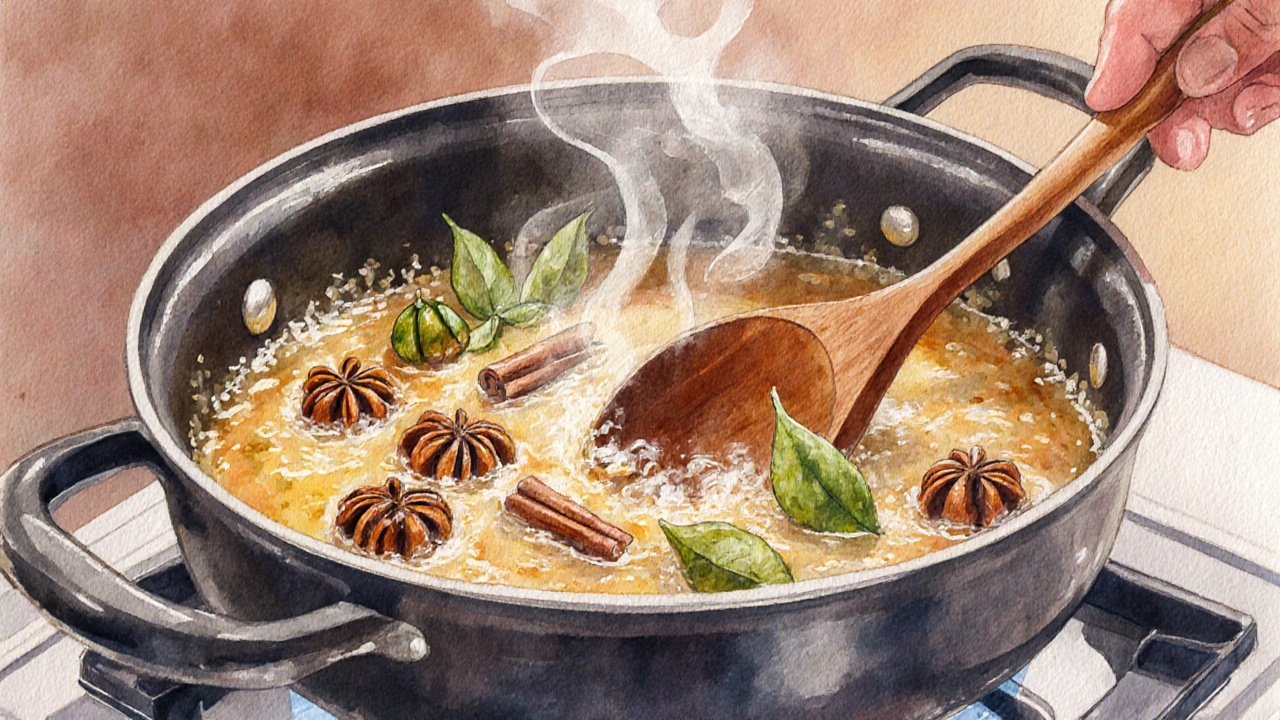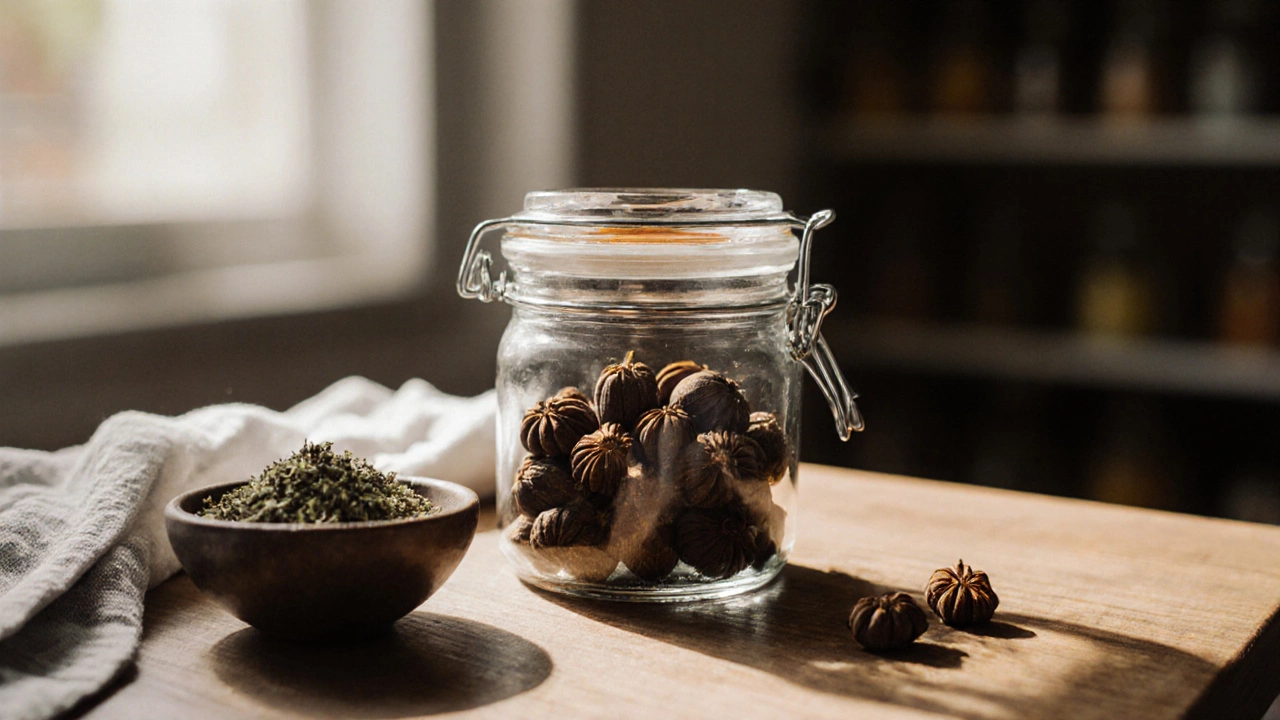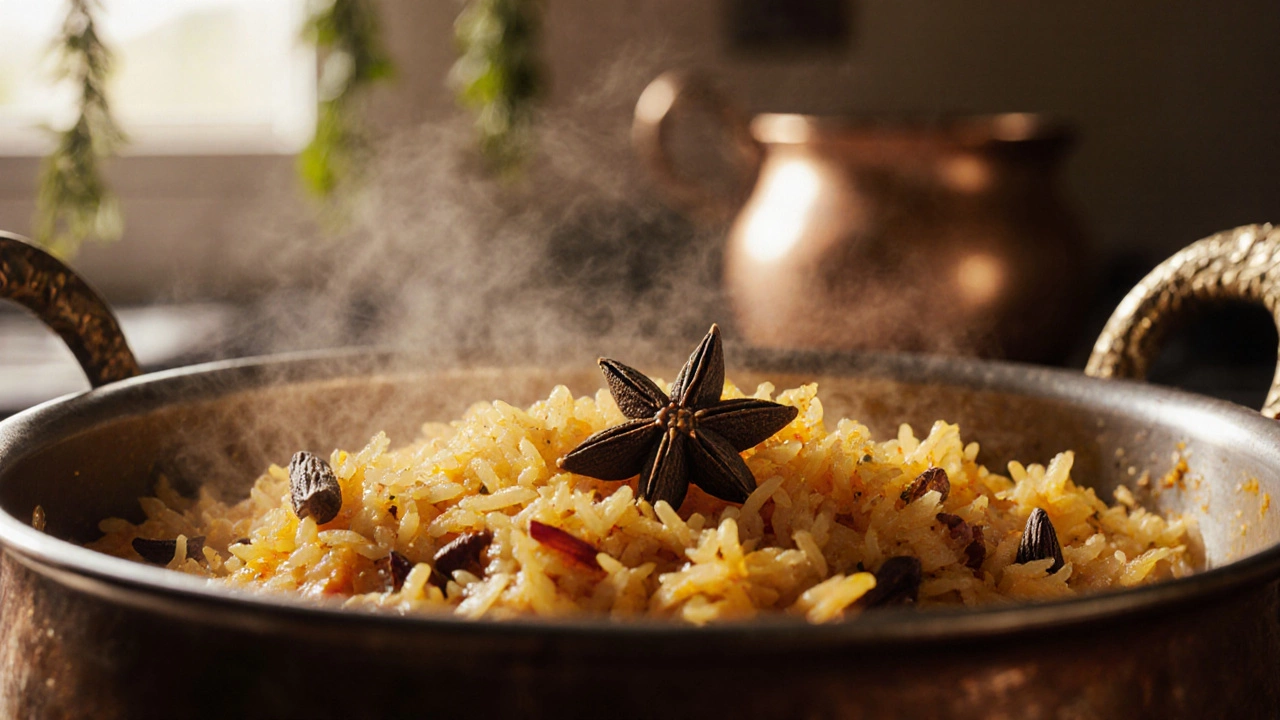Star Anise Substitution Guide
Star anise is a distinctive spice with a star-shaped pod that imparts a sweet licorice flavor to dishes like biryani. It's commonly used in Indian cuisine, particularly in Hyderabadi and Lucknow-style biryanis.
Key Features:
- Native to East Asia
- Used whole in biryani (1–2 pods per large pot)
- Removes before serving
- Best stored in airtight containers away from light
If you don't have star anise, here are some good substitutes:
| Substitute | Flavor Notes | Amount to Use | Best For |
|---|---|---|---|
| Chinese Five-Spice Powder | Mix of star anise, cloves, cinnamon, fennel, Szechuan pepper | ¼ tsp per pot | Quick pantry fix |
| Anise Seeds | Sweet licorice, milder than whole pod | ½ tsp, whole | When whole pods are pricey |
| Fennel Seeds | Fresh, slightly sweet, less licorice | 1 tsp, whole | For a lighter flavor |
| Ground Star Anise | Same flavor, stronger when over-used | ¼ tsp, ground | When you have the powder but not the pods |
- Always remove whole spices before serving
- One to two pods per large pot is sufficient
- Grind only if necessary and use sparingly
- Avoid Japanese star anise—it is toxic
If you're substituting star anise in a biryani recipe, consider using Chinese five-spice powder for convenience or fennel seeds for a lighter, more subtle flavor. Remember to adjust quantities carefully and always remove whole spices before serving.
Ever noticed a tiny star‑shaped thing tucked into a pot of biryani and wondered what it is? That little star isn’t a garnish; it’s a spice that adds a subtle sweet‑licorice note to the dish. Below we’ll break down exactly what this spice is, why cooks swear by it, and how you can use it at home.
Key Takeaways
- The star‑shaped ingredient in biryani is star anise, a whole spice native to East Asia.
- It delivers a warm, sweet‑licorice flavor that balances the heat of chilies and the earthiness of cumin.
- Use 1‑2 whole pods per large pot of biryani; remove before serving.
- Good substitutes include Chinese five‑spice powder, anise seeds, or a tiny pinch of fennel seed.
- Store in an airtight container away from light; it stays fresh for up to a year.
Identifying the Star‑Shaped Spice
When the pot is lifted, you’ll see a dark, star‑shaped pod about 2‑3 cm across. This is star anise a dried fruit of the Illicium verum tree, known for its distinct star shape and sweet‑licorice flavor. It’s a common addition in many Indian biryani recipes, especially those from the Hyderabad and Lucknow regions.
Flavor Profile and Why It Matters
Star anise brings three main qualities to biryani:
- Sweetness: A natural sweet note that softens the sharpness of garlic and onion.
- Licorice undertones: Similar to aniseed, it adds depth without overpowering.
- Warm spice: Its heat is gentle, complementing stronger spices like black pepper and clove.
These attributes help create the layered aroma that biryani is famous for. Without it, the dish can feel a bit flat, especially when you’re using a lot of chili heat.

How to Use Star Anise in Biryani
Here’s a step‑by‑step guide for incorporating star anise into a classic chicken biryani:
- Rinse 500g basmati rice and soak for 30minutes.
- Heat ghee in a heavy‑bottomed pot; add whole spices: 1‑2 pods of star anise, 4‑5 cinnamon sticks large, thick sticks that add sweet woody notes, 6 cloves dried flower buds with a strong, pungent flavor, 3 cardamom pods green pods that give a citrusy, floral aroma, and 2 bay leaves broad leaves that add subtle bitterness.
- Sauté onions, ginger‑garlic paste, and spices until fragrant (about 2‑3minutes).
- Add marinated chicken, cook for 5minutes, then layer par‑boiled rice on top.
- Cover tightly, cook on low heat (dum) for 20‑25minutes.
- Before serving, quickly lift the lid and remove the whole spices, especially the star anise pods, as they are not meant to be eaten whole.
Using whole spices keeps the flavor gentle and prevents the intense burst you’d get from powder.
Substitutes When Star Anise Isn’t Available
If you can’t find star anise, try one of these alternatives. Each mimics part of its flavor profile, though the exact aroma will differ slightly.
| Substitute | Flavor Notes | Amount to Use | Best For |
|---|---|---|---|
| Chinese five‑spice powder | Mix of star anise, cloves, cinnamon, fennel, Szechuan pepper | ¼tsp per pot | Quick pantry fix |
| Anise seeds | d>Sweet licorice, milder than whole pod½tsp, whole | When whole pods are pricey | |
| Fennel seeds | Fresh, slightly sweet, less licorice | 1tsp, whole | For a lighter flavor |
| Ground star anise | Same flavor, stronger when over‑used | ¼tsp, ground | When you have the powder but not the pods |
Remember to remove any whole substitute before serving, just like you would with the original star anise.
Storing Star Anise for Maximum Freshness
Star anise retains its flavor best when kept airtight, away from light, and in a cool place. A small glass jar with a tight‑fitting lid works fine. If you buy it in bulk, consider dividing it into portion‑size bags and freezing them; the aroma stays intact for up to 18months.

Health Benefits and Culinary Myths
Beyond flavor, star anise has a few documented health perks:
- Digestive aid: The spice contains compounds that can soothe stomach upset.
- Antioxidant properties: Its essential oils combat free radicals.
- Antimicrobial effect: Traditional medicine uses it to inhibit certain bacteria.
That said, the amounts used in biryani are tiny, so the health impact is modest. Also, beware of “Japanese star anise,” a look‑alike that is toxic. Always buy from reputable spice merchants and verify the botanical name Illicium verum.
Common Mistakes and How to Avoid Them
Even seasoned cooks slip up with this spice. Here are the most frequent errors and quick fixes:
- Leaving the pod in the finished dish: The pod is hard and not meant to be chewed. Always fish it out before serving.
- Using too many pods: One or two pods per pot is enough; extra pods can make the dish taste soapy.
- Grinding the whole pod: Grinding releases intense flavor fast, which can dominate the biryani. If you must grind, use a pinch and add it early.
- Confusing star anise with anise seeds: Though similar, they differ in potency. Adjust quantities accordingly.
Putting It All Together - A Quick Biryani Checklist
- Gather whole spices: star anise, cinnamon, cloves, cardamom, bay leaf.
- Measure 1‑2 star anise pods per large pot.
- Toast spices briefly in hot ghee before adding aromatics.
- Layer rice and meat; seal the pot for dum cooking.
- Remove all whole spices before serving; enjoy the aroma.
Frequently Asked Questions
Is star anise the same as anise seed?
No. Star anise comes from the Illicium verum tree and has a stronger, sweeter flavor. Anise seed is the seed of Pimpinella anisum and is milder. Use about half the amount of anise seed if you substitute it for star anise.
Can I add star anise to vegetarian biryani?
Absolutely. The spice works with any protein or vegetable base, adding depth to lentil, paneer, or mixed‑veg biryani.
How long does star anise stay fresh?
Stored in an airtight container, it keeps its aroma for 12‑18months. If it smells faint or has lost its star shape, replace it.
Is it safe to use the Chinese variety of star anise?
Only the Illicium verum (Chinese star anise) is safe for cooking. The similar-looking Japanese star anise (Illicium anisatum) is toxic and must be avoided.
What’s the best way to remove the pod after cooking?
Use a pair of kitchen tongs or a slotted spoon to fish the whole pods out of the pot just before you fluff the rice.
